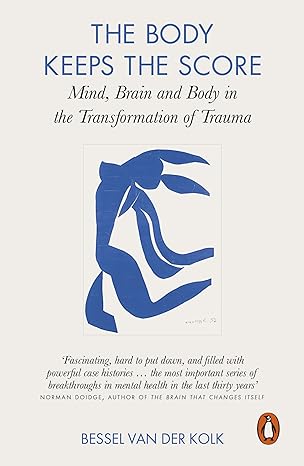More on this book
Community
Kindle Notes & Highlights
Read between
November 30, 2022 - August 16, 2023
Like many severely traumatized people, Lisa could not recognize herself in a mirror.
Delta waves, the slowest frequencies (2–5 Hz) are seen most often during sleep. The brain is in an idling state, and the mind is turned inward. If people have too much slow-wave activity while they’re awake, their thinking is foggy and they exhibit poor judgment and poor impulse control. Eighty percent of children with ADHD and many individuals diagnosed with PTSD have excessive slow waves in their frontal lobes.
neurofeedback plays a major therapeutic role in many different areas. In my opinion, if any medication had demonstrated such a wide spectrum of efficacy it would be universally accepted and widely used.”
In order to find our voice, we have to be in our bodies—able to breathe fully and able to access our inner sensations.
Standing on a stage with professional actors, speaking about their memories of the war, and reading their poetry was clearly a more transformative experience than any therapy could have offered them.
Religious rituals universally involve rhythmic movements, from davening at the Wailing Wall in Jerusalem to the sung liturgy and gestures of the Catholic Mass to moving meditation in Buddhist ceremonies and the rhythmic prayer rituals performed five times a day by devout Muslims.
Traumatized people are afraid of conflict. They fear losing control and ending up on the losing side once again. Conflict is central to theater—inner conflicts, interpersonal conflicts, family conflicts, social conflicts, and their consequences. Trauma is about trying to forget, hiding how scared, enraged, or helpless you are. Theater is about finding ways of telling the truth and conveying deep truths to your audience. This requires pushing through blockages to discover your own truth, exploring and examining your own internal experience so that it can emerge in your voice and body on stage.
‘Don’t make eye contact with anyone—just look at the floor.’ Most of them are thinking: ‘Great, I’m doing that already,’ but then I say ‘Now begin to notice people as you go by, but don’t let them see you looking.’ And next: ‘Just make eye contact for a second.’ Then: ‘Now, no eye contact … now, contact … now, no contact. Now, make eye contact and hold it … too long. You’ll know when it’s too long because you’ll either want to start dating that person or to have a fight with them. That’s when it’s too long.’
When mirroring ends in giggles, it’s a sure indication that our participants feel safe.
Because they could not tolerate any sign of weakness in themselves, they could not accept it in others. They showed nothing but contempt for potential victims,
if you treat kids in foster care with love or generosity, they often don’t know what to make of it or how to respond. Rudeness feels more familiar; cynicism they understand.
Competence is the best defense against the helplessness of trauma. This is, of course, true for all of us. When the job goes bad, when a cherished project fails, when someone you count on leaves you or dies, there are few things as helpful as moving your muscles and doing something that demands focused attention.
“If you want to give them a sense of control, you have to give them power over their destiny rather than intervene on their behalf,” Paul explains. “You cannot help, fix, or save the young people you are working with. What you can do is work side by side with them, help them to understand their vision, and realize it with them. By doing that you give them back control. We’re healing trauma without anyone ever mentioning the word.”
So we never say, ‘How did that feel?’ at the end of a scene, because it invites them to go to the judgment part of their brain.” Instead Coleman asks, “Did you notice any specific feelings that came up for you doing that scene?”
I wish I could separate trauma from politics, but as long as we continue to live in denial and treat only trauma while ignoring its origins, we are bound to fail.
Many psychiatrists today work in assembly-line offices where they see patients they hardly know for fifteen minutes and then dole out pills to relieve pain, anxiety, or depression. Their message seems to be “Leave it to us to fix you; just be compliant and take these drugs and come back in three months—but be sure not to use alcohol or (illegal) drugs to relieve your problems.” Such shortcuts in treatment make it impossible to develop self-care and self-leadership.
For older children some schools have installed workstations costing less than two hundred dollars where students can play computer games to help them focus and to improve their heart rate variability
Several of my students run an after-school program in Brazilian capoeira in a high-crime area of Boston,
(Most bullies have themselves been bullied, and they despise kids who remind them of their own vulnerability.)


